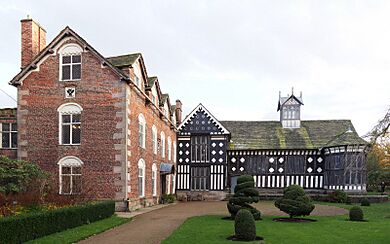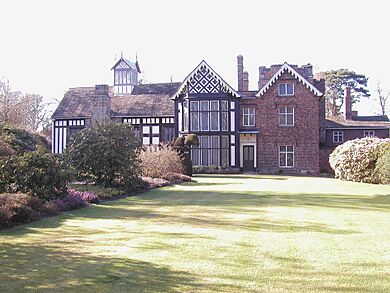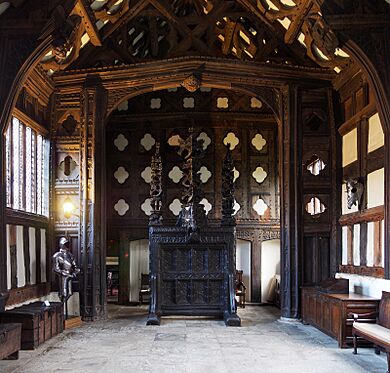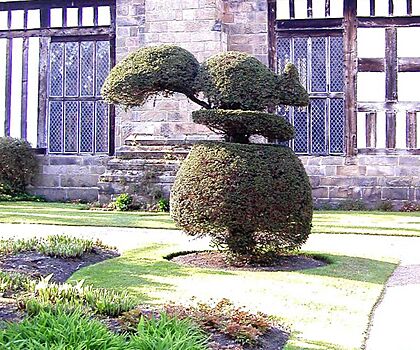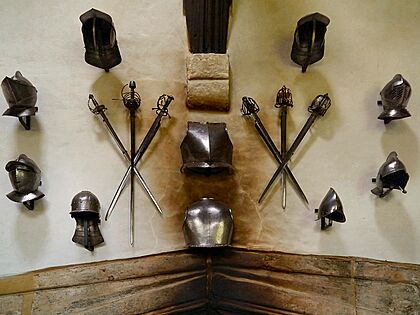Rufford Old Hall facts for kids
Quick facts for kids Rufford Old Hall |
|
|---|---|
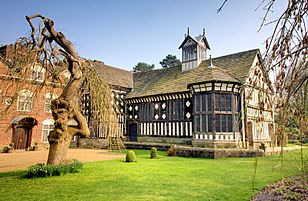
The great hall,
the oldest surviving part of the house |
|
| Type | Hall house |
| Location | Rufford, England |
| Built | Late 15th century to 1820s |
| Architectural style(s) | Tudor, Jacobean, Gothic Revival |
| Owner | The National Trust |
|
Listed Building – Grade I
|
|
| Official name: Rufford Old Hall | |
|
Listed Building – Grade II
|
|
| Official name: Cottage, coach house and stables circa 10 metres east of wing of Rufford Old Hall | |
| Lua error in Module:Location_map at line 420: attempt to index field 'wikibase' (a nil value). | |
Rufford Old Hall is a fascinating historic house in Rufford, Lancashire, England. It is now looked after by the National Trust. The Hesketh family built this amazing place in the late 1400s or early 1500s. Only the main hall, called the great hall, is left from the very first building.
Later, in 1661, a new brick part was added. This part was built in the Jacobean style, which was popular then. Another section was built in the 1820s. Rufford Old Hall is considered a very important building. It is a Grade I listed building in the UK. The smaller buildings nearby, like the cottage and stables, are also listed as Grade II.
Inside Rufford Old Hall, you can see a special carved wooden screen. It's made from bog oak and is the only one of its kind from the 1500s. The house also has a collection of old farm tools and weapons from the 1400s to the 1600s. Outside, in the Victorian gardens, you'll find two huge topiary squirrels made from trimmed trees!
Contents
History of Rufford Old Hall
How the Hall Began
Rufford Old Hall is in the village of Rufford, about 7 miles north of Ormskirk. The Hesketh family, who were important landowners, built it. The National Trust believes it was built around 1530. However, some experts think it might be even older, from the late 1400s. They compare it to other old houses in Lancashire like Smithills Hall.
It's not certain who exactly built it. Some say Sir Robert Hesketh, but the National Trust suggests his father, Sir Thomas Hesketh. There's a local story that the famous writer William Shakespeare once performed here when he was young. But there is no real proof of this.
The oldest part of the hall is the timber-framed manor house. The great hall was the middle part of a larger, H-shaped building. It's a fantastic example of Tudor building style. It has a special roof called a hammerbeam roof, which is beautifully carved. The original west wing, where the family lived, is gone. It is said to have burned down. In 1662, a new brick building was added for the family and servants. The east wing was rebuilt in the 1720s using old wood from another Hesketh home.
From the 1700s to Today
By the mid-1700s, old Tudor houses like Rufford Old Hall seemed a bit old-fashioned. So, Sir Thomas Hesketh built a new, more modern house nearby called Rufford New Hall. Rufford Old Hall was then left empty as a home around 1798. For a while, a farmer lived there, and the great hall even became a village school.
In 1821, the house was repaired and updated for Thomas Henry Hesketh, the eldest son. The east wing was made bigger and changed to match the older parts of the house. Thomas Henry Hesketh lived there until 1842. The National Trust says that these changes made Rufford Old Hall feel like a "house of Gothic romance." The Heskeths loved to fill it with old oak furniture, stained glass, and weapons.
In 1867, the Hesketh family inherited another large estate. Rufford Old Hall was no longer their main home. In 1920, Thomas Fermor-Hesketh lived there for a short time. In 1936, he gave the house, its gardens, and important historical items to the National Trust.
Since then, the National Trust has worked to furnish the hall with pieces from its original time. It became a popular place for visitors, even during the Second World War. The wooden beams in the great hall have had problems with death watch beetles twice. This caused a lot of work to fix the roof and protect the wood.
People say that Rufford Old Hall is haunted by at least three ghosts. These include a grey lady, a man in old Elizabethan clothes, and even Queen Elizabeth I.
Architecture and Design
When you first see Rufford Old Hall, you notice its cheerful front. It has a special doorway that leads to a passage and a large bay window. This window would have given light to the main dining area. The front of the house has bay windows on the right and the entrance door on the left.
The timber-framed hall is built in an old medieval style that was still used in Tudor times. The great hall is about 46.5 feet long and 22 feet wide. Its wooden frame sits on a low stone wall. The tall lantern on the roof was added in the 1800s. The hall has a stone floor and a large stone chimney. Its hammerbeam roof is very impressive. Each of the five hammerbeams ends with a carved wooden angel. Experts say the inside of the great hall is incredibly decorated and splendid.
In 1661, a brick wing was added. It was built in the Jacobean style and stands at a right angle to the great hall. This brick part looks very different from the black and white timber of the medieval hall. This wing is special because it has a balanced, symmetrical front. This was new for buildings in Lancashire at that time.
In the 1820s, a third wing was built from the old service rooms. A tower with castle-like tops was added to connect the great hall to the 1662 wing. In the 1900s, a secret room was found above the great hall. It might have been a priest hole, a hiding place for priests in the 1500s.
Inside the Hall: Fixtures and Fittings
One of the most amazing things inside is a carved wooden screen made of bog oak. It's the only one known to exist from the early 1500s. This screen is very large and heavy. It has carved panels and huge decorative pieces on top.
Much of the furniture in the hall is made of oak. This includes a very large cupboard and a cabinet from the 1500s with carved faces and scenes. There are also two special oak chairs with high backs and curved legs.
On the staircase, you can see a painting by Godfrey Kneller. It shows Thomas Hesketh, who was a Member of Parliament in 1722. He is shown with his wife Martha and son in 1723. This Thomas Hesketh was the one who rebuilt the east wing in the 1720s.
Gardens of Rufford Old Hall
We don't know much about the very early history of the gardens. Some parts, like the lawns and some of the trimmed trees, might be from the late 1700s. The gardens you see today were mostly designed in the Victorian era. Many of the large trees, like sycamores, limes, oaks, and beeches, were planted then.
When the National Trust took over in 1936, the garden was full of an invasive plant called Rhododendron ponticum. This plant has been slowly removed and replaced with other beautiful rhododendrons and shrubs.
The most famous part of the gardens is the Squirrel Border. It's on the south side of the great hall. Here, two large yew trees are shaped into giant squirrels! In the early 1900s, these same trees were shaped like peacocks. Also on the south side is the south lawn, with many flower beds, a rose garden, and tall pine trees. There are also statues of Venus and a dancing faun.
The Beech Walk Paddock has a wall of tall beech trees on one side and the Leeds and Liverpool Canal on the other. This walk used to be the main path to the hall from the village.
Rufford Old Hall has an orchard with several types of apple trees. These include Keswick Codlin, Duke of Devonshire, Lord Suffield, and Bramley's Seedling. The first record of an orchard here was in 1779.
Collections at the Hall
Armour Collection
In medieval times, weapons and armour were often kept in the great hall of a house. The Hesketh family brought back this tradition in the 1800s. The armour at Rufford comes from different parts of Europe. It includes:
- An Italian half-suit of armour from around 1600.
- A mixed suit, mostly German, from the 1500s, with a sword from the late 1600s.
- Another mostly German suit with a special chest plate popular in the mid-1500s.
- A full suit, mostly Italian, from the 1500s.
Philip Ashcroft Collection
The stables at Rufford Old Hall display large pieces of old farm equipment. These were collected by Philip Ashcroft, who lived in Rufford. Philip Ashcroft was the son of a local potato merchant. In 1936, he had the idea to create a village museum. He wanted to save old items from daily life in southwest Lancashire that were disappearing.
The first items from his collection were shown at Rufford Old Hall in 1939. Philip Ashcroft gave his collection to the National Trust in 1946. He kept adding to it until he passed away in 1959. Many of his smaller items, like pictures, furniture, dishes, fabrics, books, toys, and household tools, are now shown in the furnished rooms of the hall.
Important Building Status
Rufford Old Hall is officially recognized by English Heritage as a Grade I listed building. This means it is a building of exceptional historical and architectural importance. The cottage, coach house, and stables in the courtyard behind the hall are also listed as Grade II buildings.
See also
- Grade I listed buildings in Lancashire
- Listed buildings in Rufford, Lancashire


